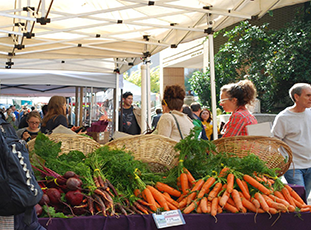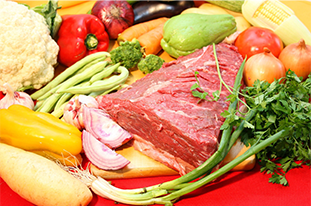Local Food Purchase Assistance Program (LFPA)

The USDA Agricultural Marketing Service established the Local Food Purchase Assistance Cooperative Agreement Program (LFPA) in early 2022. Cooperative agreements will allow for state and tribal governments to procure and distribute local and regional foods and beverages that are healthy, nutritious and unique to their geographic area. Later in the same year, USDA amended with the State of Montana to include a formula-based award using Commodity Credit Corporation (CCC) funds, to be used for food purchase only. The food will meet the needs of the population, and serve feeding programs, including food banks, schools and organizations that reach underserved communities. In addition to increasing local food consumption, funds will help build and expand economic opportunity for local and socially disadvantaged producers.
While Montana is a large producer of commodity crops, the availability of locally grown food products is limited in supply. Because the state is predominantly underserved due to its rural character, LFPA creates a unique opportunity to address these issues. LFPA can be used not only as a tool to ensure that more Montana food is ending up on the plates of Montanans, but also to initiate long term buyer-seller relationships that will grow our local food economy.

The Montana Department of Agriculture has subawarded funds to organizations statewide to increase the distribution of local food from and to underserved constituencies, and to facilitate the establishment of business relationships between underserved farmers and food purchasers in underserved communities. The primary objective of subawardees is to identify or organize producers or groups of producers in sizes to provide sufficient volume and capacity to serve underserved areas.
Funding has been used to supplement the cost of procuring and distributing food into underserved communities. The objective in supplementing food purchases is to connect underserved producers with underserved communities, while also working to establish business relationships that will carry on into the future. Grants were awarded over a two-year period for this effort:
- Day Eagle Hope Project - $200,000 award. The Day Eagle Hope Project (DEHP) is a state-certified food bank operating on the Fort Belknap Indian Reservation that will be serving both on and off-reservation communities. DEHP’s food sovereignty project will scale up its response by connecting local producers with those most vulnerable in our communities. At the core of the project will be efforts to retain locally produced beef in the community. In addition, food box distribution will be expanded into new geographic areas throughout the hi-line of Montana.
Food Focus: Beef, oats, fruit & vegetables
Access Points: three Fort Belknap reservation communities, two off-reservation towns, and the Chippewa Cree Nation.
- Helena Food Share - $200,000 award. The overall goal of our Local Foods Initiative is to meet the health and nutrition needs of our current underserved customers and to provide more Montana-produced products to the food insecure in rural locations, all while strengthening the local and hyperlocal food production economy, reducing food waste, and increasing sustainability in the local food supply chain. Services will also expand due to Helena Food Share's plans for future services, which include increasing the services of our mobile pantry throughout our service area, increasing the distribution of Kid Packs or other services focused on youth in middle and high-schools.
Food Focus: Vegetable & fruit, dairy, meat, eggs
Access Points: The Grocery Share Program, The Kid Packs Program, Senior Commodities, The Emergency Food Pack program.
- North Valley Food Bank - $155,000 award. This project is a collaboration between FAST Blackfeet (FAST), North Valley Food Bank (NVFB) and Land to Hand MT (L2H) pantries and food access programs to purchase fresh food from and build long-term relationships with underserved producers to grow the local food economy in the Blackfeet Nation and Flathead County and to ensure food insecure community members have access to locally grown food.
Food Focus: Bison, beef, locally sourced tea, fruit & vegetables
Access points: O’yo’p’ Food Pantry, meals on wheels mobile food pantry, Food Rx program, Columbia Falls schools, free grocery stores in Whitefish.
- People’s Partner for Community Development - $138,217 award. People’s Partner for Community Development in conjunction with Warrior Grocery will use the Local Food Purchase Assistance Program funding to provide high quality and nutritious food to the people of the Northern Cheyenne Indian Reservation. Around 9,000 residences will be assisted with the growth of this program.
Food Focus: Bison, beef, pork, lamb, eggs, locally-sourced bread, fruits & vegetables
Access Points: Northern Cheyenne Food Pantry; communities of Lame Deer, Muddy, Busby, Ashland, Birney. Lame Deer is centrally located within the boundaries of the reservation.
- Lake County CDC - $199,000 award. “Building Food Sovereignty within the Flathead Reservation” builds the capacity of underserved producers to meet the food needs of their communities. The project is a collaboration between the CSKT Food Sovereignty Team (CSKTFST), SKC Extension Program (SKCE), CSKT Office of Economic Development (CSKTED), Arlee CDC (ACDC), and Mission West (MW). The project will focus on underserved communities and producers within the CSKT/Flathead reservation and increase the consumption of locally grown food through a focused local procurement and distribution program within the reservation. The project outcomes will be the expansion of food distribution within the Flathead Reservation and support new and emerging producers in accessing new markets.
Food Focus: Vegetables & fruit (majority), beef
Access Points: WMGC, Flathead Reservation, Kicking Horse food hub, developing 8 new distribution points with 3 points within each of those.
- Helping Hands in Hardin - $200,000 award. Helping Hands in Hardin seeks to grow the local food economy and provide equitable food access and nutrition across Big Horn County. Forward contracting with local farmers and ranchers, prioritizing traditional foods, and expanding garden resources allows Helping Hands to increase local procurement by 25% over the next two years.
Food Focus: Game meat, fruit & veg, shelf-stable foods for emergency program
Access Points: Big Horn Food Pantry, Crow Reservation community partners, Plenty Doors LLC
- Flathead Food Bank – $108,000 award. The Flathead Food Bank seeks to expand working relationships and build new partnerships with several growers, producers, and processors in and around the Flathead Valley by using grant funds to purchase bulk quantities of food items in order to meet the growing demand for food distribution services in the community. Grant funding will allow the Flathead Food Bank to supplement the regular purchase of staple pantry commodities such as pastas, canned vegetables, beans, soups, and more with fresh, healthy, and locally-sourced products from rural producers in Northwest Montana.
Food Focus: Legumes, grains, fruit & vegetables, beef
Access Points: Flathead Food Bank, 58,000 residents
- Ravalli County Economic Development Authority - $108,000 award. O’Hara Commons Local Foods Market has an established online marketplace that enables producers to sell to consumers. This platform can easily be adapted to serve the program’s target, underserved citizens. OCSC has relationships with farms that will participate. Outreach will be conducted by inviting underserved users to quarterly engagement workshops, demonstrating how to use the online platform, use EBT to purchase foods in farmers market settings, store, and prepare local foods. Coupons will be distributed to participants that will enable them to receive Food Boxes every other week for 11 weeks.
Food Focus: Food boxes rotate fresh ingredients every other week to create nutritious meals
Access Points: Darby, Stevensville, Victor, & Hamilton distribution hubs
- HRDC - $108,000 award. HRDC purchases locally-produced food from a minimum of three local producers and three regional producers, in an effort to formalize a purchasing and distribution program that supports underserved local and regional producers while increasing the availability of fresh, nutritious food for those facing hunger. Funding will be used to pilot a program, which we will continue to build and expand into the future, expanding the 5-county reach to 7.
Food Focus: Vegetables, eggs, dried meat
Access Points: Gallatin Valley Food Bank, mobile distribution from Boz to Billings up to Meagher County.
- Montana Food Bank - $108,000 award. The Farm to Food Bank project serves two purposes: (1) Encourage network partners to initiate and/or expand their local producer partnerships with funding to support purchases of local foods and (2) Allow tribal partners and smaller capacity food pantries the opportunity to acquire and distribute local foods utilizing Montana partnerships established by MFBN. The primary outcome of the Farm to Food Bank program is to increase acquisition and distribution of locally produced agriculture products within the emergency food system. This will be done by (1) building relationships between community food pantries and their local producers, and (2) facilitating the purchasing and distribution of local foods to network partners lacking the capacity to create these partnerships on their own.
Food Focus: Vegetable & fruit, grains, dairy
Access Points: Full state access, tribal communities Outcomes of this project will be the distribution of local food from and to underserved constituencies, the organization of producer groups, establishment of business relationships with underserved communities, and identification of best business practices.
Contact
